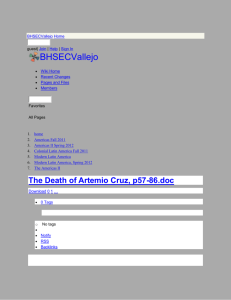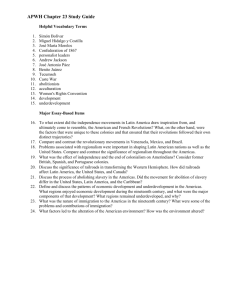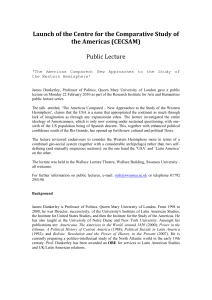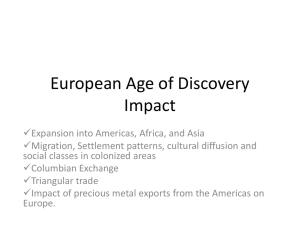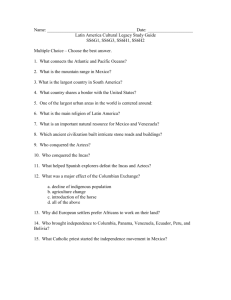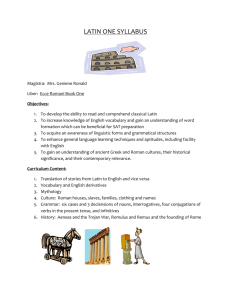Pd 3 - Mr. Trainor's Page
advertisement
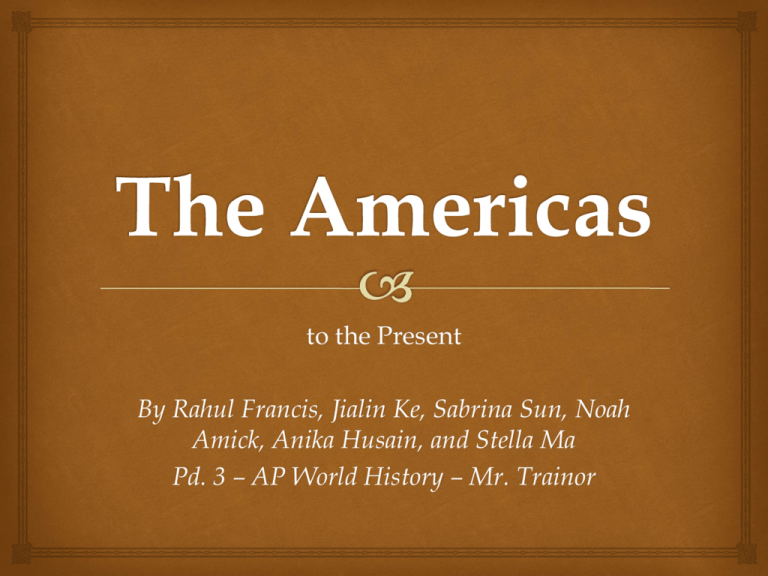
to the Present By Rahul Francis, Jialin Ke, Sabrina Sun, Noah Amick, Anika Husain, and Stella Ma Pd. 3 – AP World History – Mr. Trainor Period 1: to 600 B.C.E. Technological and Environmental Transformations Key Concept 1.1. Big Geography and the Peopling of the Earth Archeological evidence indicates that during the Paleolithic era, hunting-foraging bands of humans gradually migrated from their origin in East Africa to the Americas, adapting their technology and cultures to new climate regions. Humans used fire in new ways: to aid hunting and foraging, to protect against predators, and to adapt to cold environments. Humans developed a wider range of tools specially adapted to different environments from tropics to tundra. Economic structures focused on small kinship groups of hunting-foraging bands that could make what they needed to survive. However, not all groups were self-sufficient; they exchanged people, ideas, and goods. Key Concept 1.2. The Neolithic Revolution and Early Agricultural Societies Beginning about 10,000 years ago, the Neolithic Revolution led to the development of new and more complex economic and social systems. Possibly as a response to climatic change, permanent agricultural villages emerged in Mesoamerica and the Andes. Agriculture led to more reliable food supplies, which increased the population As a result, these surpluses led to labor specialization and development of elites. Increased technology also led to increase wealth and trade, which created more hierarchical social structures and promoted patrilineal societies. Key Concept 1.3. The Development and Interactions of Early Agricultural, Pastoral, and Urban Societies Core and foundational civilizations developed in a variety of geographical and environmental settings where agriculture flourished. Olmecs in Mesoamerica and Chavin in Andes The first states developed in core civilizations Culture played a significant role in unifying states through laws, language, literature, religion, myths, and monumental art. In the Americas, monumental architecture, urban planning and record keeping all began to develop. Period 2: 600 B.C.E. – 600 C.E. Organization and Reorganization of Human Societies Key Concept 2.1. The Development and Codification of Religious and Cultural Traditions Codifications and further developments of existing religious traditions provided a bond among the people and an ethical code to live by. Most Mesoamerican and Andean religions were polytheistic. Artistic expressions, including literature and drama, architecture, and sculpture, show distinctive cultural developments. Mesoamerica developed a distinct architectural style. Key Concept 2.2. The Development of States and Empires The number and size of key states and empires grew dramatically by imposing political unity on areas where previously there had been competing states. Teotihuacan and the Mayan city-states (Mesoamerica) Moche (Andean South American) Empires and states developed new techniques of imperial administration based, in part, on the success of earlier political forms. Administrative institutions such as central governments and bureaucracies were created. These institutions also projected military power over larger areas through diplomacy, supply lines, defense and fortification, and the creation of a military or soldier class. Key Concept 2.3. Emergence of Transregional Networks of Communication and Exchange New technologies facilitated long-distance communication and exchange. The invention of things such as the yoke, saddle, and stirrup made the use of pack animals (particular llamas in the Americas) possible and practical. Alongside the trade in goods, the exchange of people, technology, religious and cultural beliefs, food crops, domesticated animals, and disease pathogens developed across far-flung networks of communication and exchange. Period 3: 600 C.E. – 1450 C.E. Regional and Transregional Interactions Key Concept 3.1. Expansion and Intensification of Communication and Exchange Networks Improved transportation technologies and commercial practices led to an increased volume of trade, and expanded the geographical range of existing and newly active trade networks. Trading cities began to be formed such as Tenochtitlan in Mesoamerica and Cahokia in North America Rulers imported luxury goods for public performances and for their upscale lifestyle Teotihuacan was a state that was also one of the main producers of tools and jewelry Teotihuacan’s economy and religious impact attracted many pilgrims from far off lands and prompted them to become permanent citizens Key Concept 3.2. Continuity and Innovation of State Forms and Their Interactions Empires collapsed and were reconstituted; in some regions new state forms emerged. Toltec’s militarized the empire Warriors were very important and many pieces of artwork depicted warfare After the fall of Toltec’s, Aztec empire rose Aztec’s did not have a two leader empire like the Toltec, they had one supreme ruler Tribute system was added by the Aztecs Defeated states weren’t conquered, but instead forced to pay tribute Key Concept 3.3. Increased Economic Productive Capacity and Its Consequences Innovations stimulated agricultural and industrial production in many regions. Mainly agricultural because elites forced peasants onto farms so they could produce food to support the large population Built irrigation systems and terraces to support influx in agriculture Chinampas (raised fields created along lake shores) became a popular tool because it resisted frost and allowed for year round agriculture Did not discover the wheel for a very long time and utilized pulleys to create buildings instead Period 4: 1450 C.E. – 1750 C.E. Global Interactions Key Concept 4.1. Globalizing Networks of Communication and Exchange Technological developments in cartography, navigation, and shipbuilding made transoceanic crossings possible. Northern Atlantic crossings for fishing and settlements continued and spurred European searches for multiple routes to Asia. The new global circulation of goods was facilitated by royal chartered European monopoly companies that took silver from Spanish colonies in the Americas to purchase Asian goods for the Atlantic markets. The Atlantic system involved the movement of goods, wealth, and free and unfree laborers, and the mixing of African, American, and European cultures and peoples. European colonization led to the spread of disease and vermin in the Americas which killed large amounts of the native populations. American foods became staples across the Atlantic and plantations with forced labor began to arise. Afro-Eurasian crops, animals, and slaves were brought to the Americas. Key Concept 4.2. New Forms of Social Organization and Modes of Production Traditional peasant agriculture increased and changed, plantations expanded, and demand for labor increased. These changes both fed and responded to growing global demand for raw materials and finished products. The growth of the plantation economy in America increased the demand for coerced labor such as African slaves, the hacienda and encomienda systems, the Spanish adaptation of the Inca mit’a, etc. As new social and political elites changed, they also restructured new ethnic, racial, and gender hierarchies. e.g. The Creole elites in Spanish America The massive demographic changes in the Americas resulted in new ethnic and racial classifications. Key Concept 4.3. State Consolidation and Imperial Expansion Rulers used a variety of methods to legitimize and consolidate their power. This included religious ideas (e.g. human sacrifice practiced by the Mexicas/Aztecs). States treated different ethnic and religious groups in ways that utilized their economic contributions while limiting their ability to challenge the authority of the state. The Spanish created a separate “República de Indios” for the native population. Imperial expansion relied on the increased use of gunpowder, cannons, and armed trade to establish large empires in the Western Hemisphere. The Portuguese, Spanish, Dutch, French, and British all began to establish maritime empires in the New World. Competition over trade routes, state rivalries, and local resistance all provided significant challenges to state consolidation and expansion. Piracy in the Caribbean is an example Changes and Continuities Over Time: 1450 C.E. – 1750 C.E. Religion began to be introduced through foreign conquests. Catholicism was introduced during colonization and some early colonists practiced forced conversion of native people to Catholicism. Throughout this period in time, religion continued to play a huge role in the cultural aspect of society. Over time, it also began to intertwine with government affairs. Period 5: 1750 C.E -1900 C.E. Industrialization and Global Integration Key Concept 5.1: Industrialization and Global Capitalism New patterns of trade and production developed and further integrated the global economy as industrialists sought raw material and new markets for the increasing amount and array of goods produced in their factories. The need for raw materials for the factories and increased food supplies for the growing population in urban centers led to the growth of export economies around the world that specialized in mass producing single natural resources. The rapid increases in productivity caused by industrial production encouraged industrialized states to seek out new consumer markets for their finished goods. Latin America became important market for European and American consumer goods Key Concept 5.2: Imperialism and Nation State Formation Industrialized states (particularly America) practiced economic imperialism on Latin American countries. The 1808 ban against the international slave trade in America as well as the anti-slavery movement stopped most AmericanAfrican trade and caused plantations to fail. The decline of plantations required the United States to turn elsewhere for crops and raw materials, particularly Latin America. The U.S. began a form of economic imperialism that resulted in many foreign interests monopolizing Latin American economies. Examples include the United Fruit Company and the U.S. control of Cuban sugar. New ideas about nationalism, race, gender, class, and culture also developed that facilitated the spread of transoceanic empires, as well as justified anti-imperial resistance and the formation of new national identities. Key Concept 5.3: Nationalism, Revolution, Reform Increasing discontent with imperial rule propelled reformist and revolutionary movements. The American Revolution - taxes and no representation In 1804, Haiti was the first Latin American country to be independent. Slaves and the gens de couleur (led by Toussaint) rose up against the white planters who has abused them. Increasing questions about political authority and growing nationalism contributed to anticolonial movements. Napoleon's conquest of Spain triggered the revolutions that ensued. Feeling no loyalty to a French king, the creoles (led by Bolivar and San Martin) broke away and freed Spanish colonies. Key Concept 5.4: Global Migrations Migration in many cases was influenced by changes in demography in both industrialized and unindustrialized societies that presented challenges to existing patterns of living European and Asian immigration to Latin America (particulary Argentina, Chile, Brazil) increased dramatically because of indentured servitutde, which had replaced slavery. Receiving societies did not always embrace immigrants, as seen in the various degrees of ethnic and racial prejudice and the ways states attempted to regulate the increased flow of people across their borders. Asians were more often discriminated against than Europeans. Europeans were also stereotyped. People blamed immigrants for causing hardships for native workers by accpeting low wages and threatened national culture by resisting assimiltion. Period 6: 1900 C.E. - Present Accelerating Global Change and Realignments Key Concept 6.1. Science and the Environment Researchers made rapid advances in science that spread throughout the world, assisted by the development of new technology. Modern communication and transportation eliminated the problem of global distance. The Green Revolution produced food for the growing global population as it changed agricultural methods. Medical innovations eradicated diseases that plagued poorer nations in Latin America. Oil and nuclear power raised productivity and production. Humans exploited natural resources. Effects include deforestation, global warming, and pollution. Improved military technology meant that larger amounts of people died in attacks. Key Concept 6.2. Global Conflicts and their Consequences Movements to redistribute land and resources developed within states in Latin America, sometimes advocating communism and socialism. World War I and World War II were the first “total wars.” Governments used ideologies, including fascism, nationalism and communism, to mobilize all of their state’s resources, including peoples, both in the home countries and the colonies or former colonies, for the purpose of waging war. The shift of global political and economic balance after World War II led to the emergence of the U.S. and Soviet Union as superpowers. The Cold War broke out as an ideological struggle between capitalism and communism New military alliances (NATO and Warsaw Pact) led to proxy wars in Latin America as the U.S. and the Soviet Union fought to ally with smaller nations. Key Concept 6.3. New Conceptualizations of Global Economy, Society, and Culture At the beginning of the century in the United States, the government played a minimal role in their national economy. With the onset of the Great Depression, governments began to take a more active role in economic life. At the end of the twentieth century, many governments encouraged free market economic policies and promoted economic liberalization. e.g. The U.S. under Reagan, Chile under Pinochet States, communities, and individuals became increasingly interdependent, a process facilitated by the growth of institutions of global governance. Formation of the United Nations, NAFTA, WHO, WTO… Popular and consumer culture became global. Changes and Continuities Over Time: 1900 C.E. - Present Global trade slowed down during the Great Depression, with nearly a 62% decrease. North American multinational corporations began to have foreign interests in Latin America with the decline of cheap labor in the U.S. Examples include the U.S. control of Cuban sugar and the United Fruit Company in Guatemala This oppressive foreign presence created a large gap between the rich and the poor and angered many peasants in Latin America. This led to revolutions (many of them Communist/socialist) in Latin America, such as Fidel Castro’s Cuban revolution. Despite this, many nations in the Americas continued to export many important goods Europe, Asia, and Africa. Works Cited AP World History Course and Exam Description. Publication. CollegeBoard, n.d. Web. 10 May 2014. Eddins, O. Ned. Alternate Pre-Historic Indian Routes - Anthropik Network. Digital image. Paleo-Indian Migration of North and South America. N.p., 2002. Web. Latin America, 1800-1850. Digital image. Student Atlas. Rand McNally, 2005. Web. McDougal, Holt. World History: Patterns of Interaction. Evanston, I.L.: Holt McDougal, 2010. Print. Olson-Raymer, Gayle. Missile Crisis 1962. Digital image. The Cold War in the International Arena. Humboldt State University, 10 May 2014. Web. Ropp, Lydia. A map of the Americas showing the three major Mesoamerican civilizations of the Middle Ages. Digital image. The Americas. Skyline High School, 28 July 2000. Web. Topographical map illustrating 3000 years of Meso-America beginning with the Olmec Chiefdoms followed by the Mayans and then eventually the Aztecs. Digital image. Mesoamerican Civilizations and Sustainability. Museum of the City, n.d. Web. 10 May 2014 Thanks for watching!
